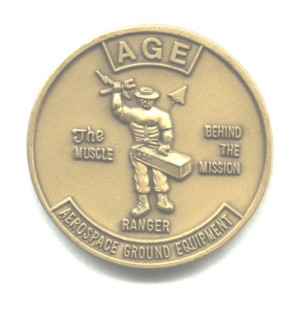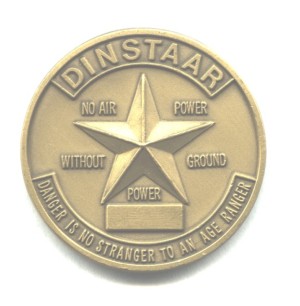 |
 |
Coin Challenge History
 |
 |
During World War I, American volunteers from all parts of the country filled the newly formed flying squadrons. Some were wealthy scions attending colleges such as Yale and Harvard who quit in midterm to join the war. In one squadron, a wealthy lieutenant ordered medallions struck in solid bronze carrying the squadron emblem for every member of his squadron. He himself carried his medallion in a small leather sack about his neck.
Shortly after acquiring the medallions, this pilot's aircraft was severely damaged by ground fire. He was forced to land behind enemy lines and was immediately captured by a German Patrol. In order to discourage his escape, the Germans took all of his personal identification except for the small leather pouch around his neck. In the meantime, he was taken to a small French town near the front. Taking advantage of a bombardment that night he donned civilian clothes and escaped. However, he was without personal identification.
He succeeded in avoiding German patrols and reached the front lines. With great difficulty, he crossed no-man's land. Eventually, he stumbled into a French outpost. Unfortunately, the French in this sector of the front had been plagued by saboteurs. They sometimes masqueraded as civilians and wore civilian clothes. Not recognizing the young pilot's American accent, the French thought him to be a saboteur and made ready to execute him. Just in time, he remembered his leather pouch containing the medallion. He showed the medallion to his would-be executioners. His French captors recognized the squadron insignia on the medallion and delayed long enough for him to confirm his identity. Instead of shooting him, they gave him a bottle of wine.
Back with his squadron, it became a tradition to ensure that all members carried their medallion or coin at all times. This was accomplished through a challenge in the following manner, a challenger would ask to see the coin, If the challenger could not produce his coin, he was required to purchase a drink of choice for the member who had challenged him. If the challenged member produced his coin, then the challenging member was required to pay for the drink. This tradition continued throughout the war and for many years after while surviving members of the squadron were still alive.
AGE Rangers proudly continue this tradition today!
b. The response consists of all those persons being challenged drawing their coin in a like manner (other organizational coins are invalid). You must produce a coin with YOUR UNIT'S LOGO on it.
c. If you are challenged and are unable to properly respond, you must buy a round of drinks for the challenger and the group being challenged.
d. If everyone being challenged responds in the correct manner, the challenger must buy a round of drinks for all those people he challenged.
e. Failure to buy a round is a despicable crime and will require that you turn-in your Coin to the issuing agency.
2. Coin checks are permitted, ANY TIME, ANY PLACE'. (Keep OPSEC in mind, be smart!)
3. There are no exceptions to the rules. They apply to those clothed or unclothed. At the time of the challenge you are permitted one step and an arms reach to locate your coin. If you still cannot reach it -- SORRY ABOUT THAT!
4. A Coin is a coin. Coins attached on belt buckles are considered "belt buckles." Coins on key chains are considered "key chains." Coins placed in a "holder/clasp" and worn around the neck like a necklace are valid and are considered a coin.
|
|
|
|
|
|
|
|